Mechanism and Prevention of Rock Burst in a Wide Coal Pillar under the Superposition of Dynamic and Static Loads
Abstract
:1. Introduction
2. Engineering Background
3. Critical Failure Conditions of Wide Coal Pillars under the Combined Effect of Dynamic and Static Loading
3.1. Stress Conditions
3.2. Energy Conditions
4. The Mechanical Response and Dynamic Instability Mechanism of Coal Pillars under Dynamic Load Disturbance
4.1. Model Establishment
4.2. Simulation Scheme
4.3. Mechanical Response of Wide Coal Pillars under Combined Dynamic and Static Loads
- (1)
- Mechanical response of the coal pillar under different initial static loads without a dynamic load applied
- (2)
- Mechanical response of coal pillar under a given dynamic load (10 MPa) and different static loads
- (3)
- Mechanical response of coal pillar under a given static load (9 MPa) and different dynamic loads
4.4. Critical Conditions of Dynamic Instability of Wide Coal Pillars under the Superposition of Dynamic and Static Loads
- (1)
- Critical failure analysis of coal pillar under a given dynamic load and different static loads
- (2)
- Critical failure analysis of coal pillar failure under a given static load and different dynamic loads
4.5. Dynamic Instability Mechanism of Wide Coal Pillars under Superimposed Disturbance from Dynamic and Static Loads
5. Prevention and Control Plan of Rock Burst Induced by Wide Coal Pillars
5.1. Energy Release Scheme for Roof Blasting
5.2. Load Reduction Scheme for Coal Mass
5.3. Control Effect Analysis
6. Conclusions
Author Contributions
Funding
Data Availability Statement
Conflicts of Interest
References
- Gu, S.; Wang, C.; Li, W.; Gui, B.; Jiang, B.; Ren, T.; Xiao, Z. Study on the technical management practice of rock burst prevention and control—Case study of Yankuang Energy Group Co., Ltd. Geohazard Mech. 2023; in press. [Google Scholar]
- Pan, Y.S.; Song, Y.M.; Liu, J. Pattern, change and new situation of coal mine rockburst prevention and control in China. Chin. J. Rock. Mech. Eng. 2023, 42, 2081–2095. [Google Scholar]
- Li, W.S.; Jiang, B.Y.; Gu, S.T.; Yang, X.X.; Shaikh, F.U.A. Experimental study on the shear behavior of grout-infilled specimens and micromechanical properties of grout-rock interface. J. Cent. South. Univ. 2022, 29, 1686–1700. [Google Scholar] [CrossRef]
- Gong, F.Q.; He, Z.C.; Jiang, Q. Internal mechanism of reducing rock burst proneness of rock under high stress by real-time drilling pressure relief. Rock. Mech. Rock. Eng. 2022, 55, 5063–5081. [Google Scholar] [CrossRef]
- Dou, L.; Tian, X.; Cao, A.; Gong, S.; He, H.; He, J.; Cai, W.; Li, X. Current situation and difficulties in the prevention and control of coal mine burst in China. J. Coal Ind. 2022, 47, 152–171. [Google Scholar]
- Wen, Z.; Jing, S.; Song, Z.; Jiang, Y.; Tang, J.; Zhao, R.; Xiao, Q.; Zhang, T.; Wang, H.; Zhao, H.; et al. Study on coal face spatial structure model and control related dynamic disasters. Coal Sci. Technol. 2019, 47, 52–61. [Google Scholar]
- Qi, Q.; Pan, Y.; Li, H.; Jiang, D.; Shu, L.; Zhao, S.; Zhang, Y.; Pan, J.; Li, H.; Pan, P. Theoretical basis and key technologies for coal and rock dynamic disaster prevention and control in deep coal mining. J. Coal Sci. 2020, 45, 1567–1584. [Google Scholar]
- Wojtecki, L.; Goda, I. A Comparison of the seismic effects of different blasting types executed during the longwall mining of a coal seam. J. Min. Sci. 2020, 56, 947–961. [Google Scholar] [CrossRef]
- Li, W.; Jiang, B.; Li, Z.; Wang, L.; Yang, X. Strength and failure characteristics of coal measures mudstone specimens containing a prefabricated flaw under true triaxial tests. J. Cent. South. Univ. 2024, 31, 196–209. [Google Scholar] [CrossRef]
- Andrieux, P.; Hadjigeorgiou, J. The destressability index methodology for the assessment of the likelihood of success of a large-scale confined destress blast in an underground mine pillar. Int. J. Rock. Mech. Min. Sci. 2008, 45, 407–421. [Google Scholar] [CrossRef]
- Bruce, H.; Jim, G. A review of the geomechanics aspects of a double fatality coal burst at Austar Colliery in NSW, Australia in April 2014. Int. J. Min. Sci. Technol. 2017, 27, 3–7. [Google Scholar]
- Konicek, P.; Soucek, K.; Stas, L.; Singh, R. Long-hole destress blasting for rockburst control during deep underground coal mining. Int. J. Rock. Mech. Min. 2013, 61, 141–153. [Google Scholar] [CrossRef]
- Yu, X.; Wang, Q.; Zhao, B.; Bo, Q.; Wang, H. Research on the reasonable width of coal pillars between roadways in large mining height double lane arrangement working face. J. Rock. Mech. Eng. 2015, 34, 3328–3336. [Google Scholar]
- Zhang, G.; He, F. Asymmetric failure mechanism and control measures of the roof of the fully mechanized top coal caving roadway under large cross-section strong mining. J. Rock. Mech. Eng. 2016, 35, 806–818. [Google Scholar]
- Wang, H. Research on the Creep Characteristics and Stability Control Technology of Narrow Side of Gob Tunnel; China University of Science and Technology: Xuzhou, China, 2011. [Google Scholar]
- Zhang, J.; Song, Z.; Liu, J.; Dong, X.; Zhang, Y.; Qi, Q.; Zhao, S.; Qin, K.; Chen, J.; Yan, T. Technical framework for structural control of rock burst disasters in deep coal mining. Coal Sci. Technol. 2022, 50, 27–36. [Google Scholar]
- Nian, J.; Zhao, B.; Zhang, W. Numerical simulation research on the pressure relief and permeability enhancement mechanism of large-diameter borehole in coal seam. Geofluids 2022, 2022, 2926213. [Google Scholar] [CrossRef]
- Kan, J.L.; Dou, L.M.; Li, X.W.; Li, J.Z.; Chai, Y.J. Investigating the destressing mechanism of roof deep-hole blasting for mitigating rock bursts in underground coal mines. Geomat. Nat. Hazards Risk 2022, 13, 2508–2534. [Google Scholar] [CrossRef]
- Singh, R.; Singh, A.K.; Maiti, J.; Mandal, P.K.; Singh, R.; Kumar, R. An observational approach for assessment of dynamic loading during underground coal pillar extraction. Int. J. Rock. Mech. Min. 2011, 48, 794–804. [Google Scholar] [CrossRef]
- Dou, L.; Bai, J.; Li, X.; He, H. Research on the prevention and control technology of rock burst disasters based on the principle of dynamic and static load superposition. Coal Sci. Technol. 2018, 46, 1–8. [Google Scholar]
- Dou, L.M.; Cai, W.; Cao, A.Y.; Guo, W.H. Comprehensive early warning of rock burst utilizing microseismic multi-parameter indices. Int. J. Min. Sci. Technol. 2018, 28, 767–774. [Google Scholar] [CrossRef]
- Cai, W.; Dou, L.M.; Gong, S.Y.; Li, Z.L.; Yuan, S.S. Quantitative analysis of seismic velocity tomography in rock burst hazard assessment. Nat. Hazards 2015, 75, 2453–2465. [Google Scholar] [CrossRef]
- Wang, G.; Zhu, S.; Jiang, F.; Zhang, X.; Liu, J.; Wang, X.; Ning, T.; Zhang, Y.; Wei, Q. Coal pillar key layer structure instability type mine earthquake mechanism in inclined thick coal seam fully mechanized caving working face. J. Coal Sci. 2022, 47, 2289–2299. [Google Scholar]
- Zhang, M.; Jiang, F.; Li, K.; Wang, C.; Wu, X.; Gao, H.; Ji, S. Research on coordinated deformation and stability of thick rock strata coal pillar system. J. Rock. Mech. Eng. 2017, 36, 326–334. [Google Scholar]
- Wang, T.; You, S.; Pei, F.; Bai, X. Instability mechanism and prevention technology of free coal pillar under hard roof condition. J. Min. Saf. Eng. 2017, 34, 54–59. [Google Scholar]
- Guo, W.; Deng, K.; Zou, Y. Theoretical study on catastrophic failure and instability of striped coal pillars. J. China Univ. Min. Technol. 2005, 1, 80–84. [Google Scholar]
- Fulawka, K.; Mertuszka, P.; Pytel, W.; Szumny, M.; Jones, T. Seismic evaluation of the destress blasting efficiency. J. Rock. Mech. Geotech. Eng. 2022, 14, 1501–1513. [Google Scholar] [CrossRef]
- Hosseini, N. Evaluation of the rockburst potential in longwall coal mining using passive seismic velocity tomography and image subtraction technique. J. Seism. 2017, 21, 1101–1110. [Google Scholar] [CrossRef]
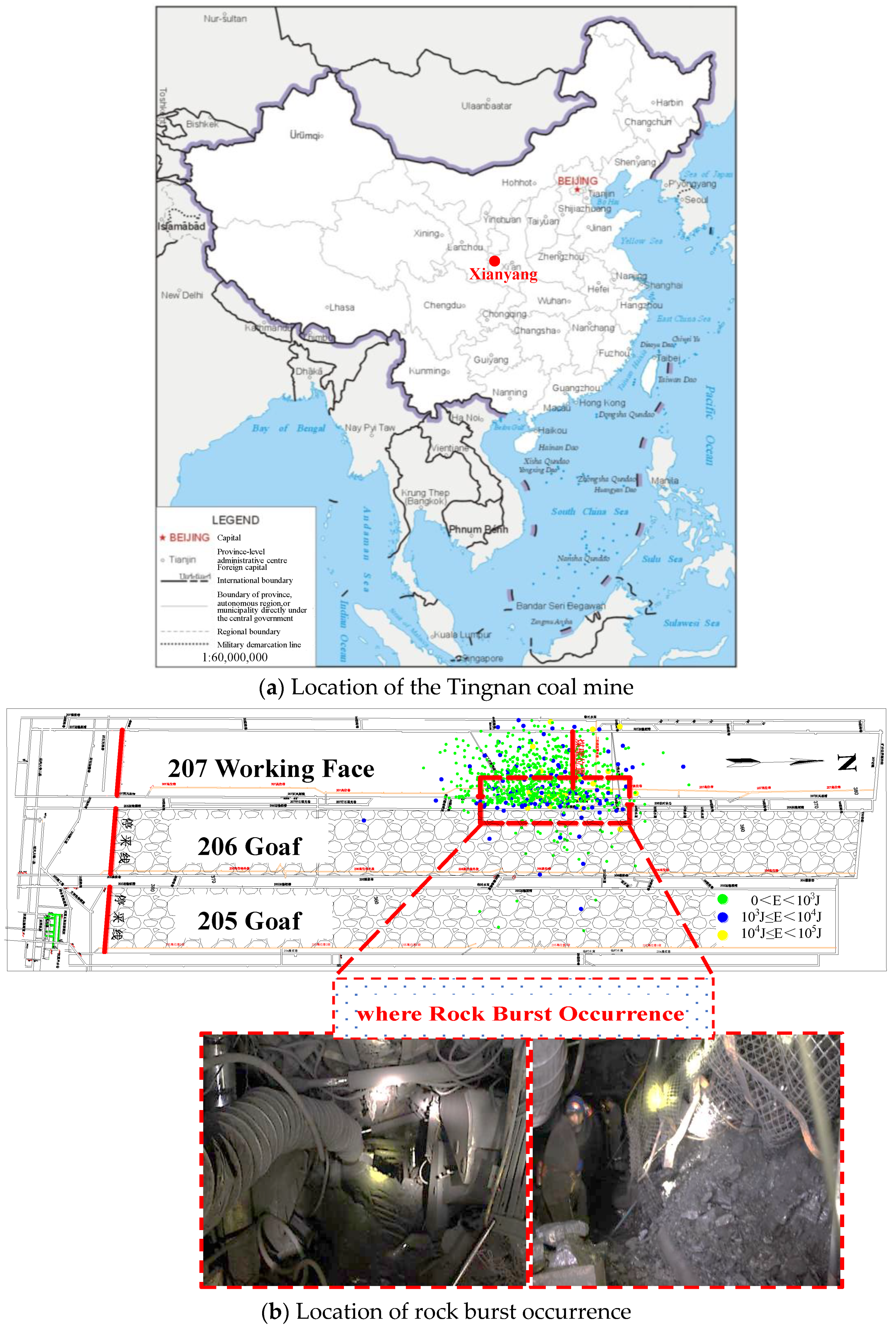


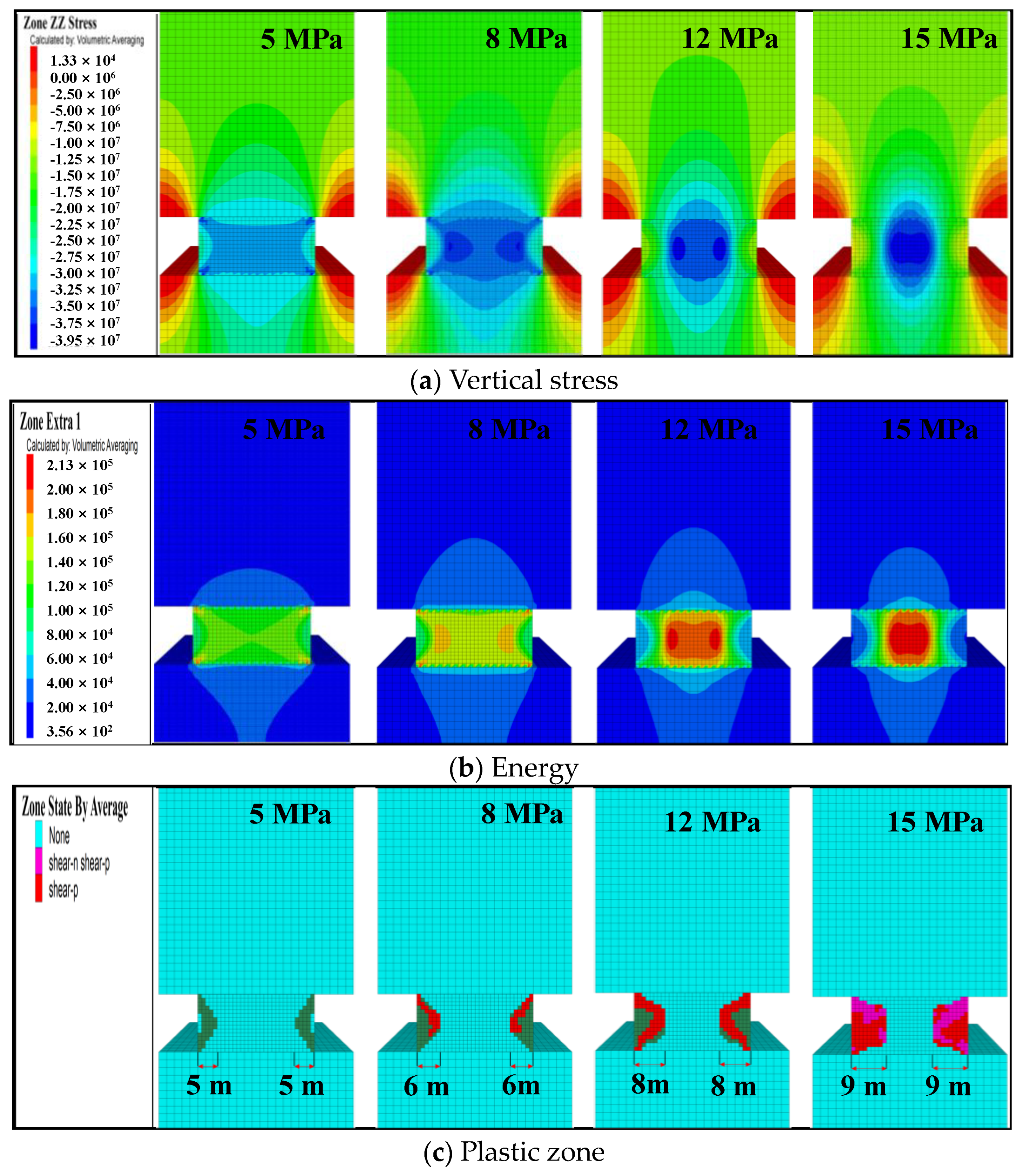

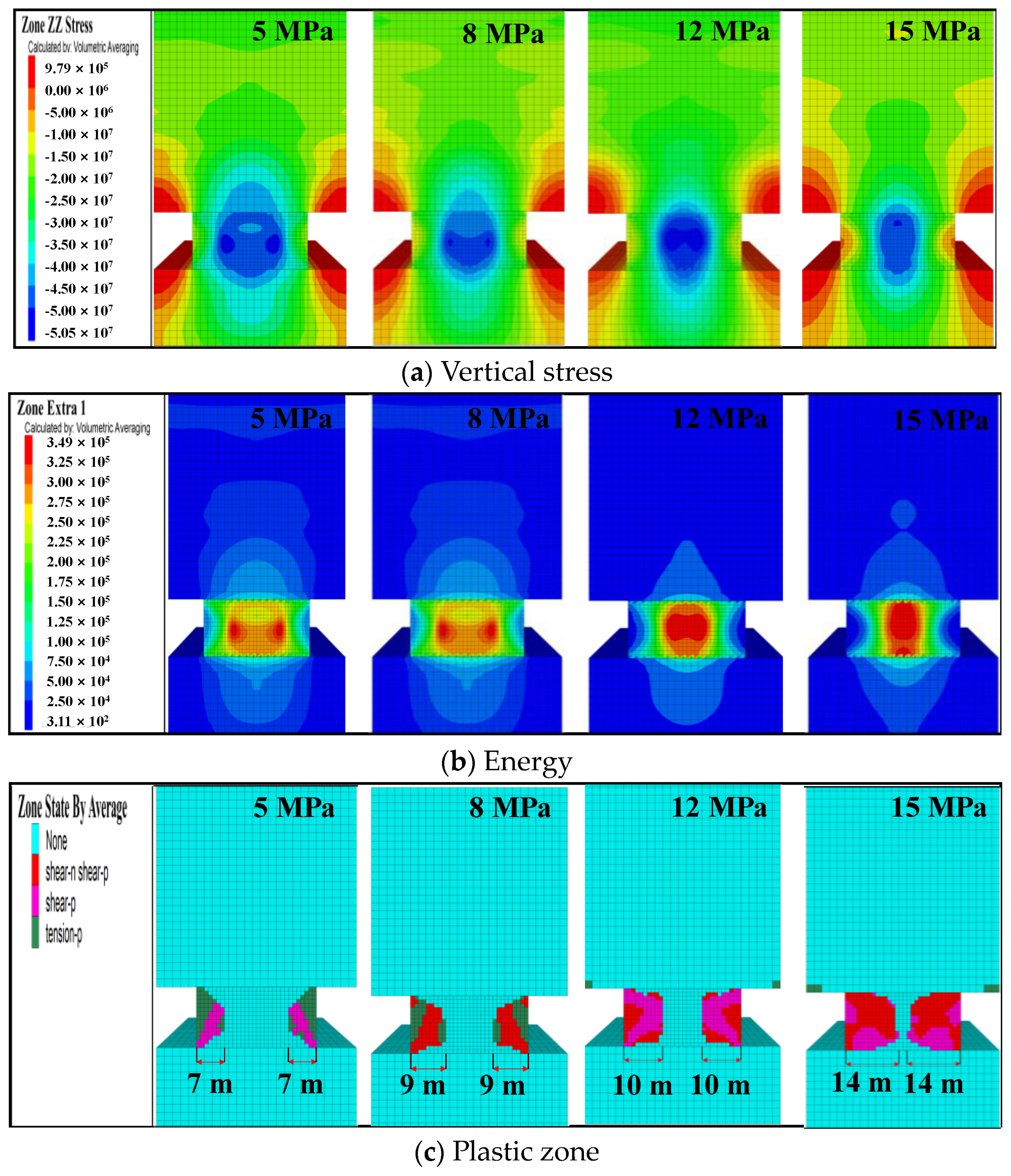
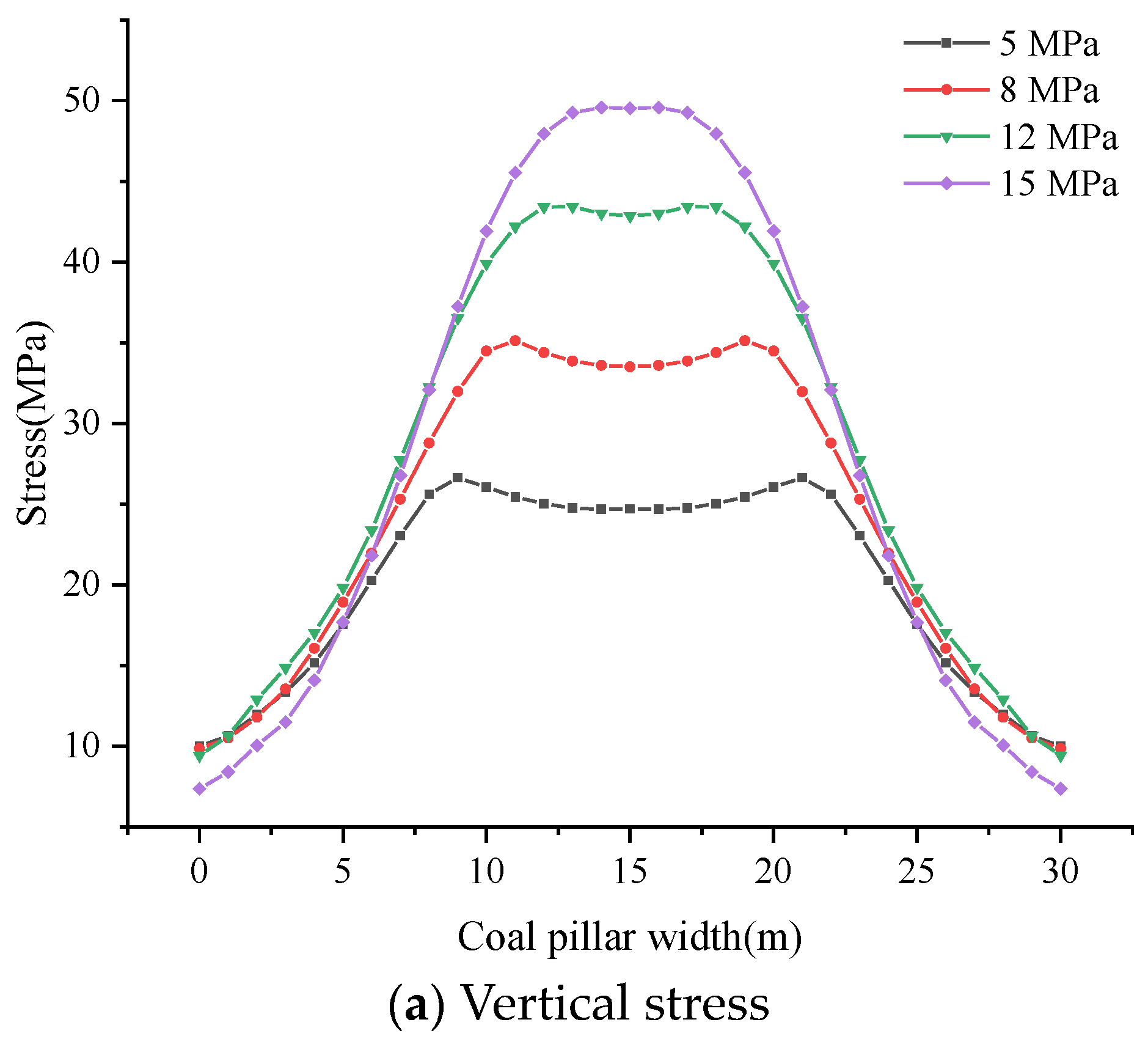

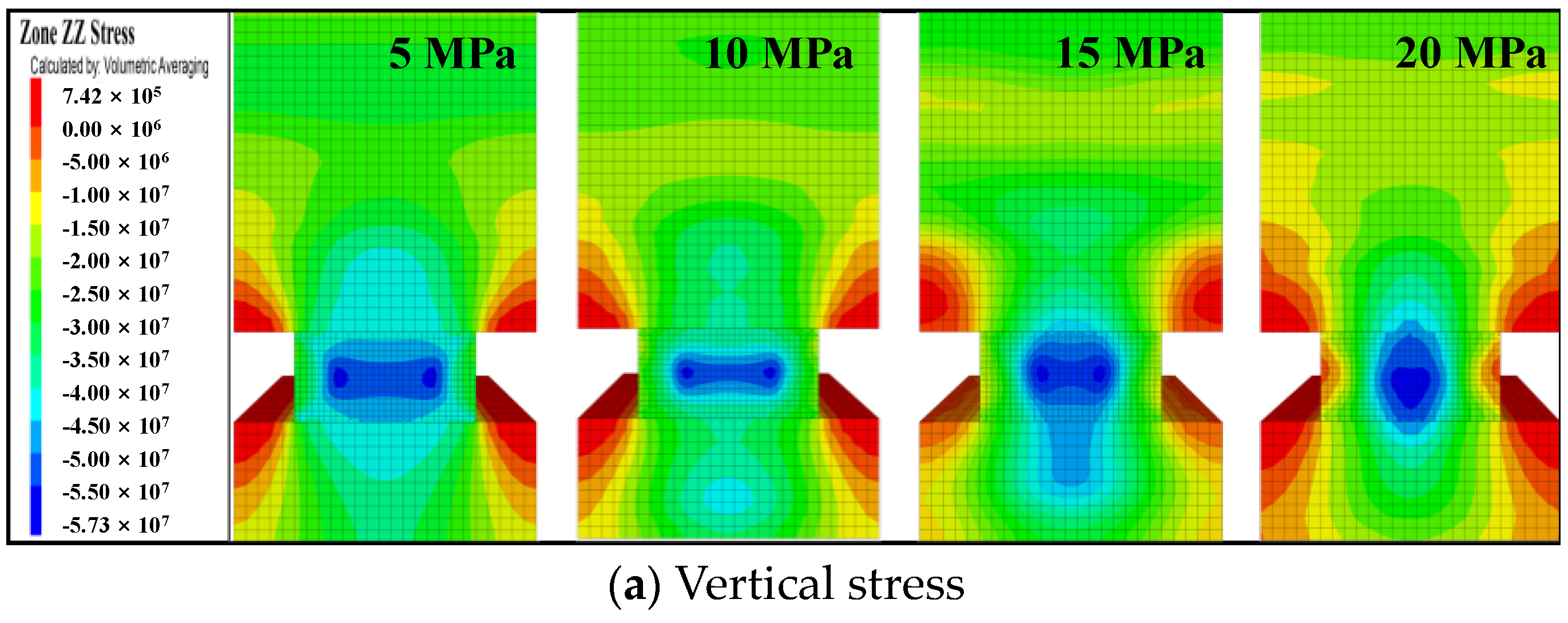

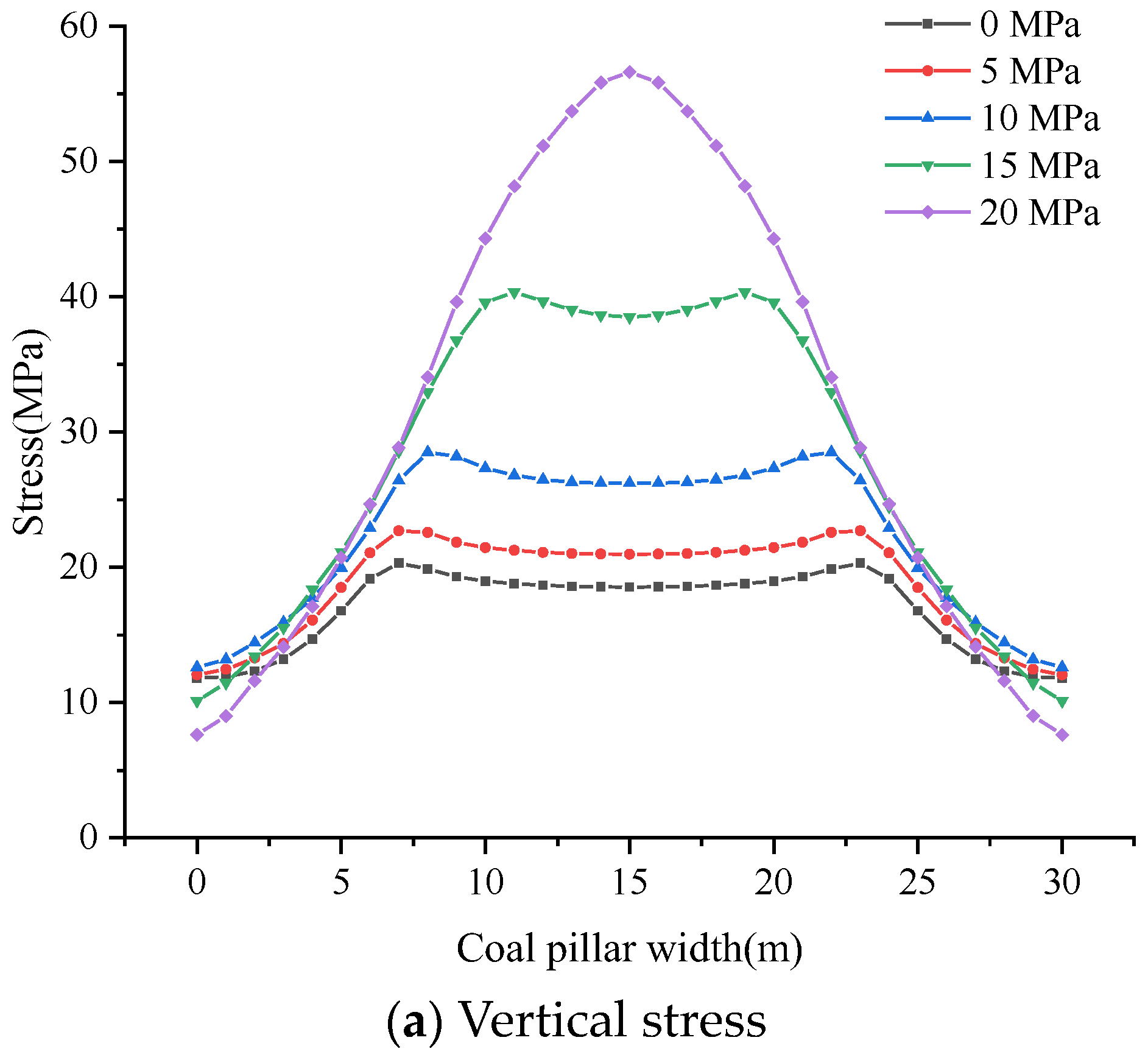
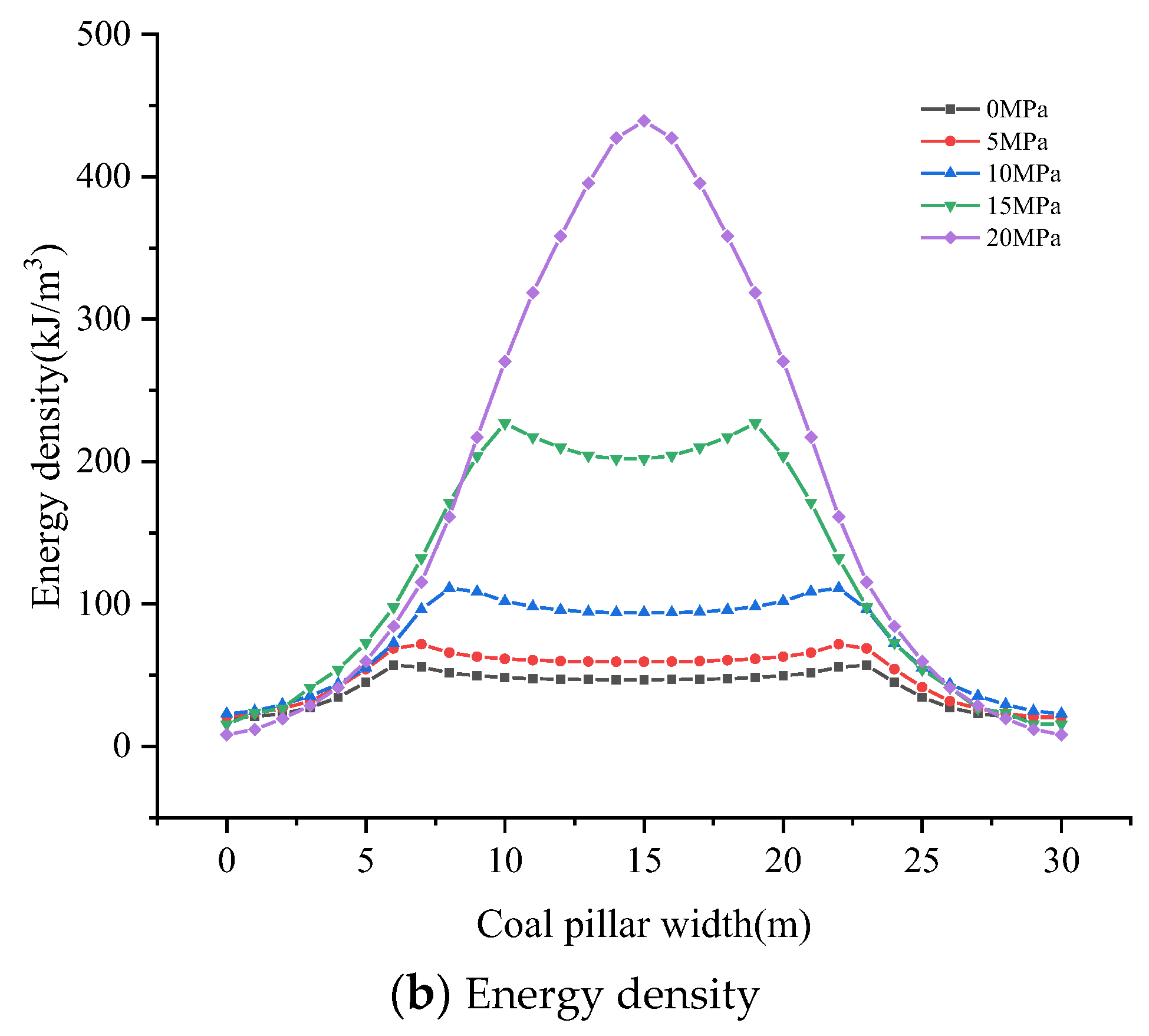
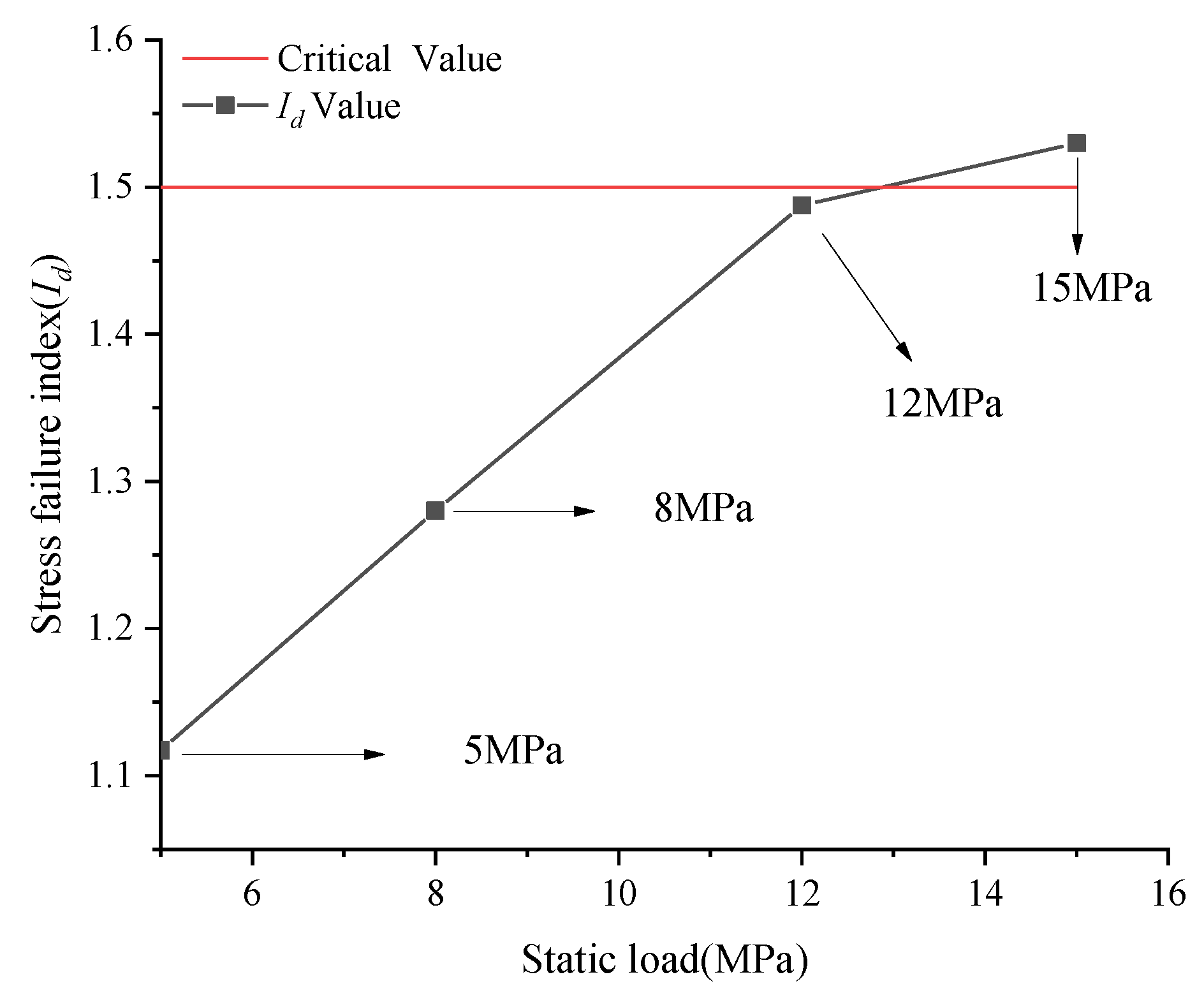


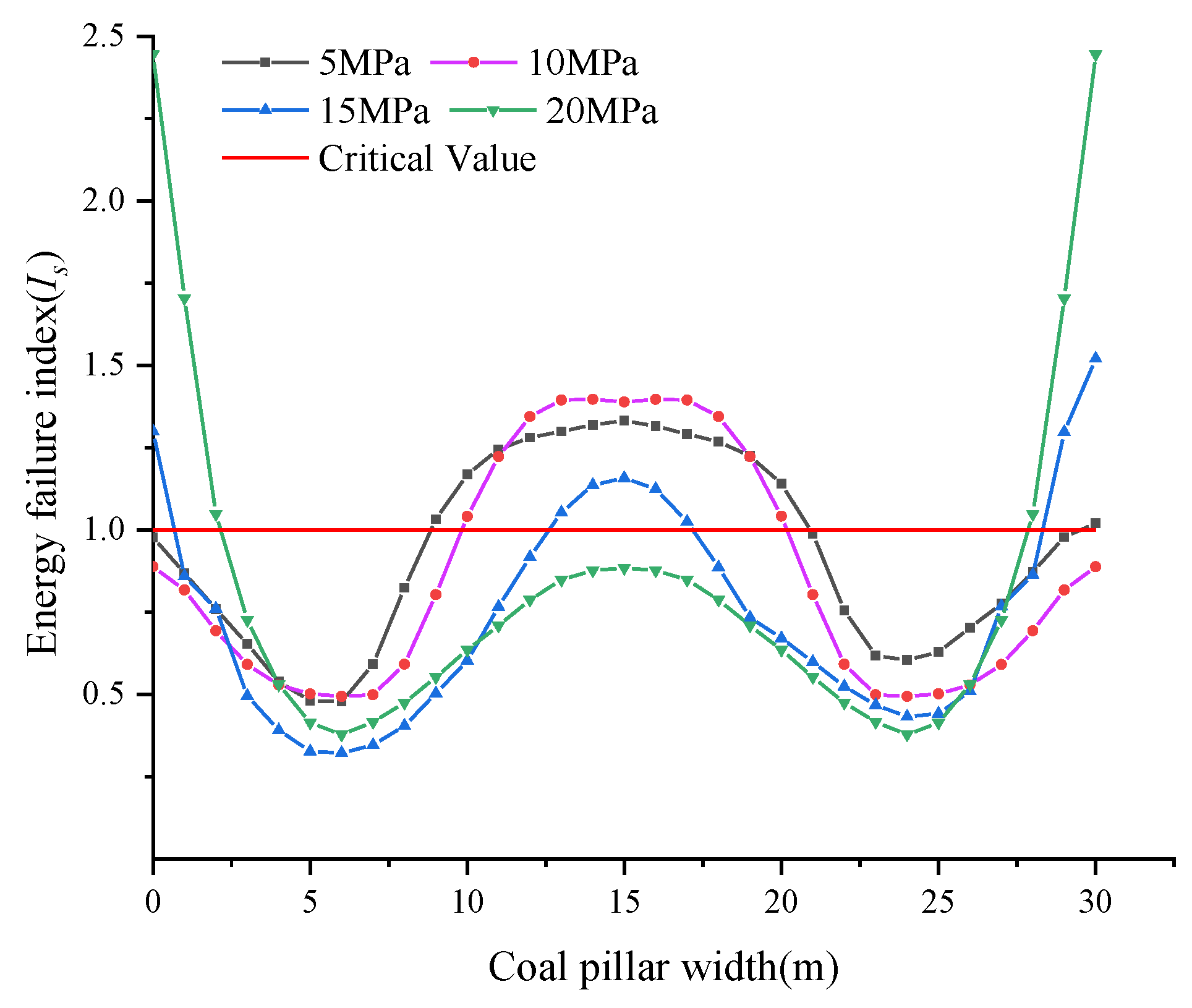


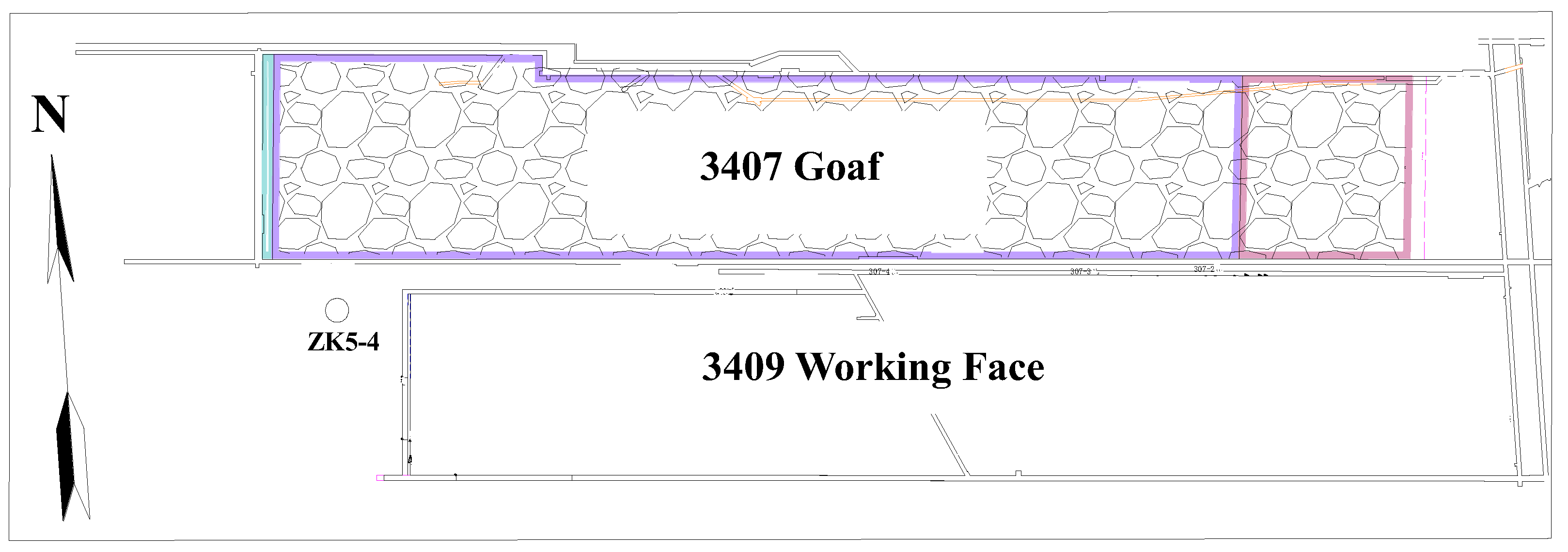
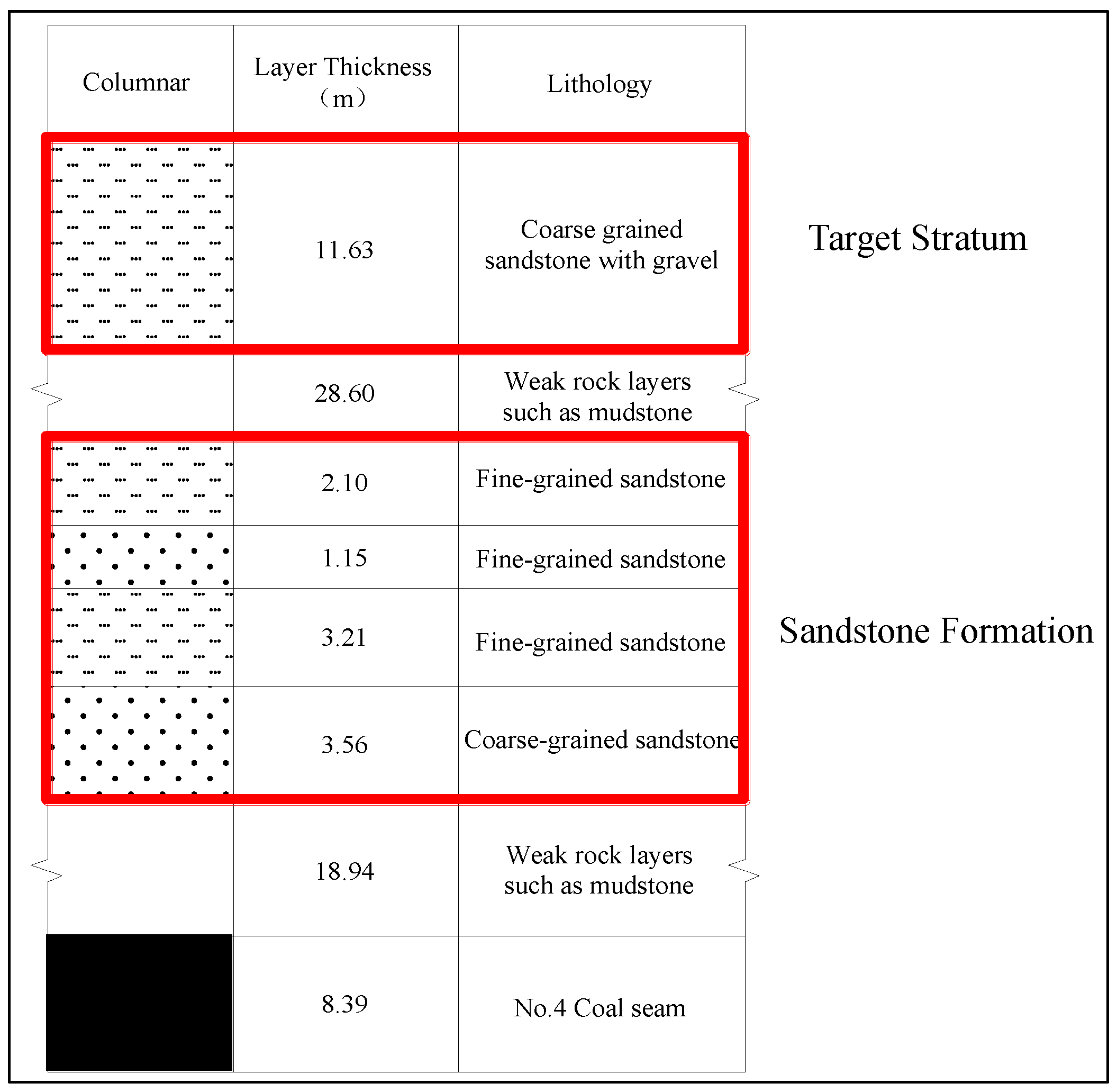
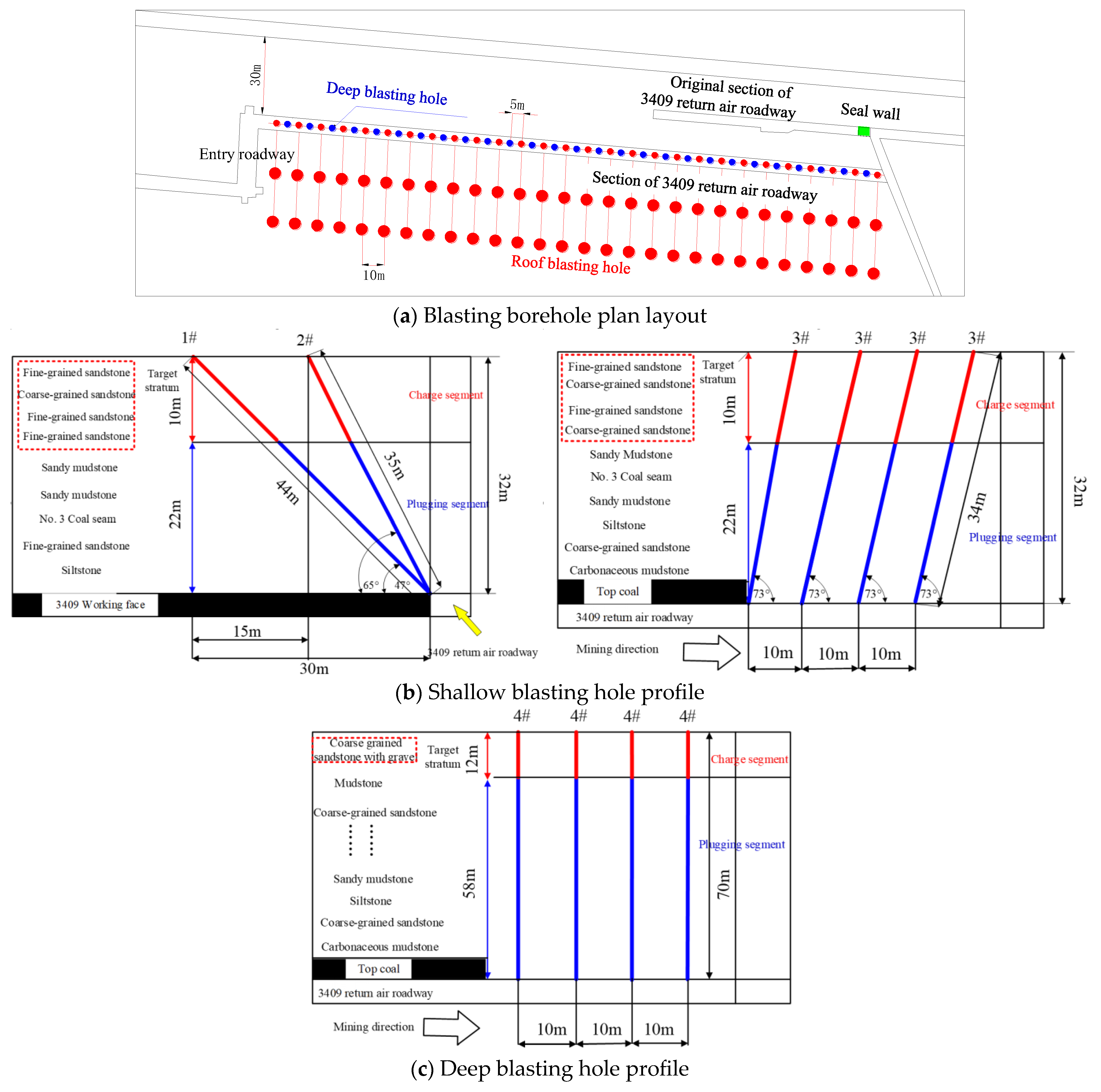
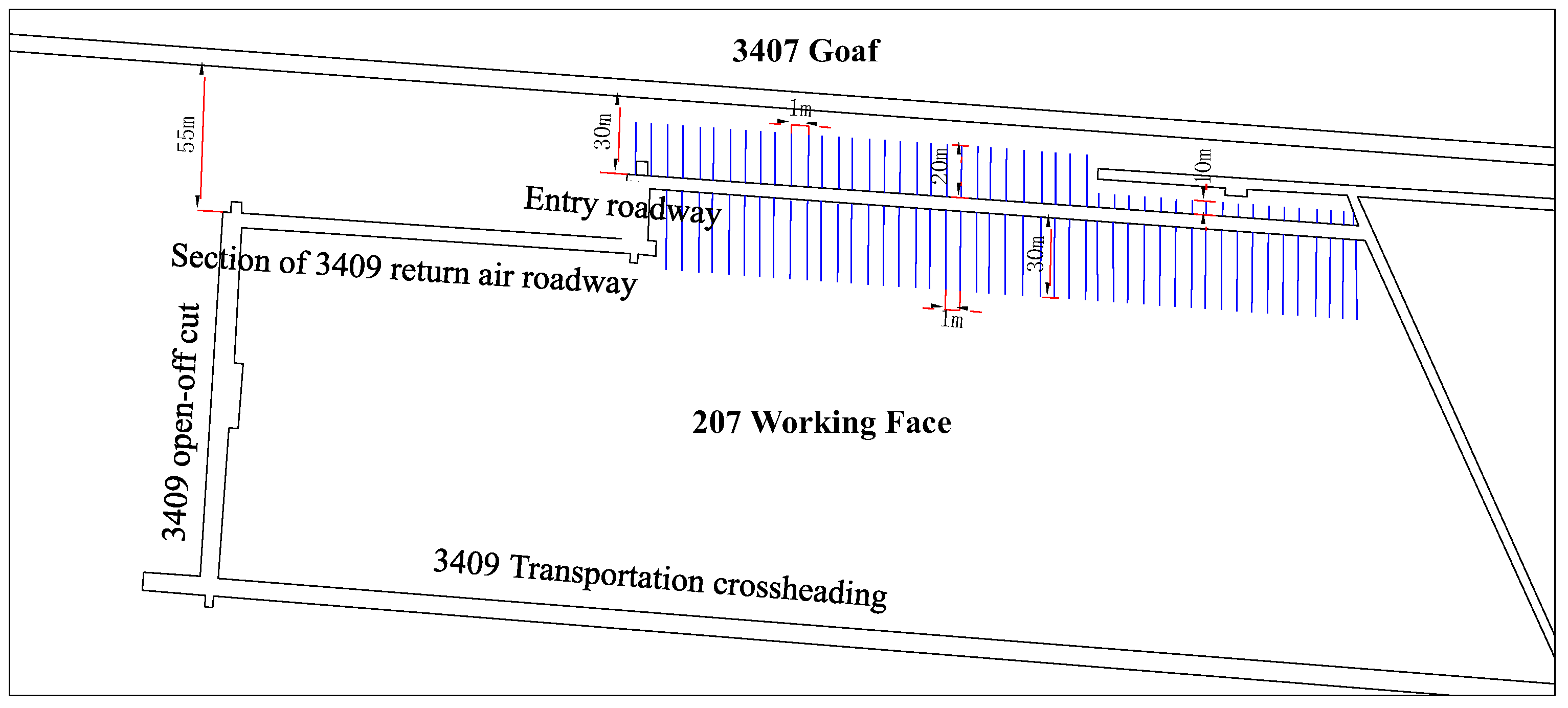
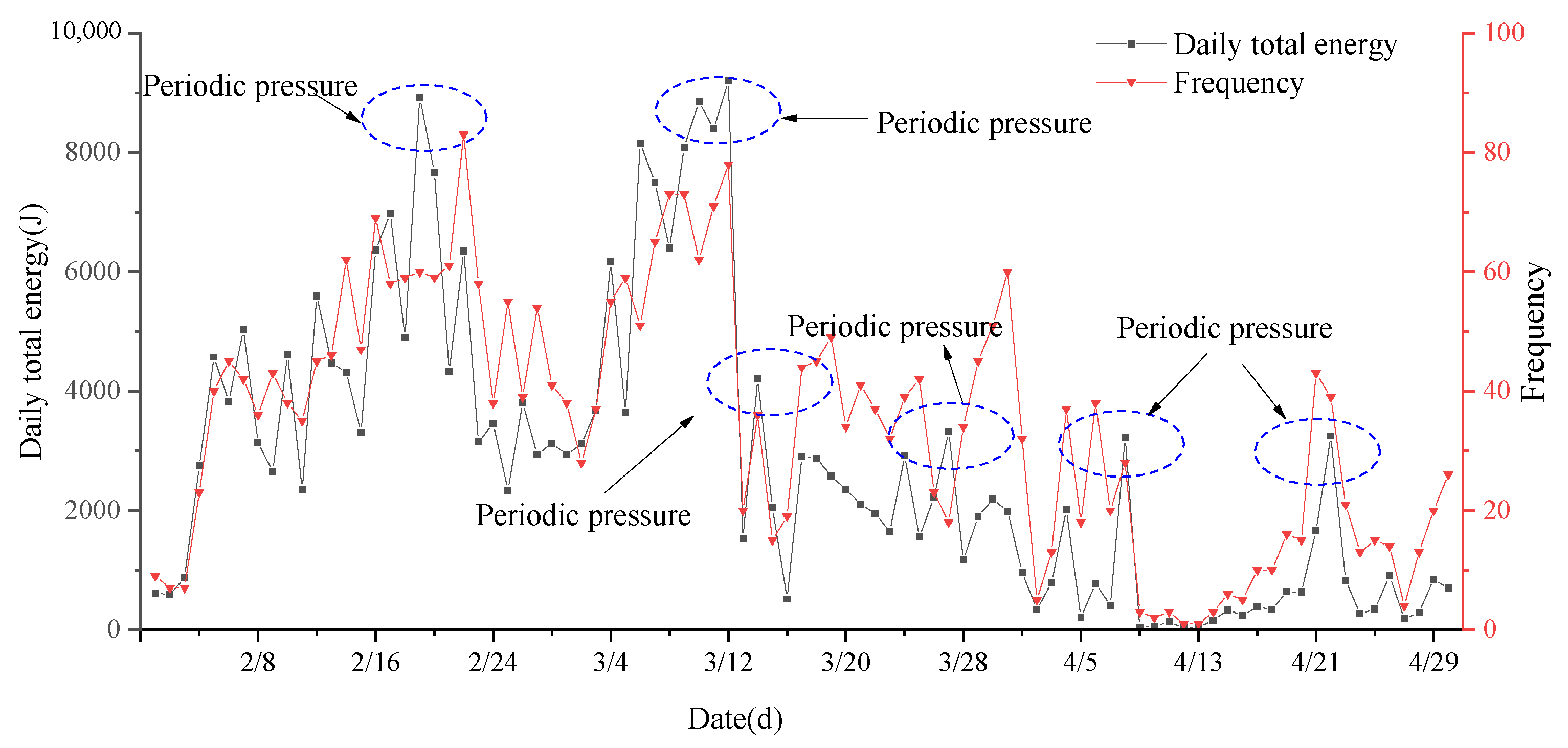
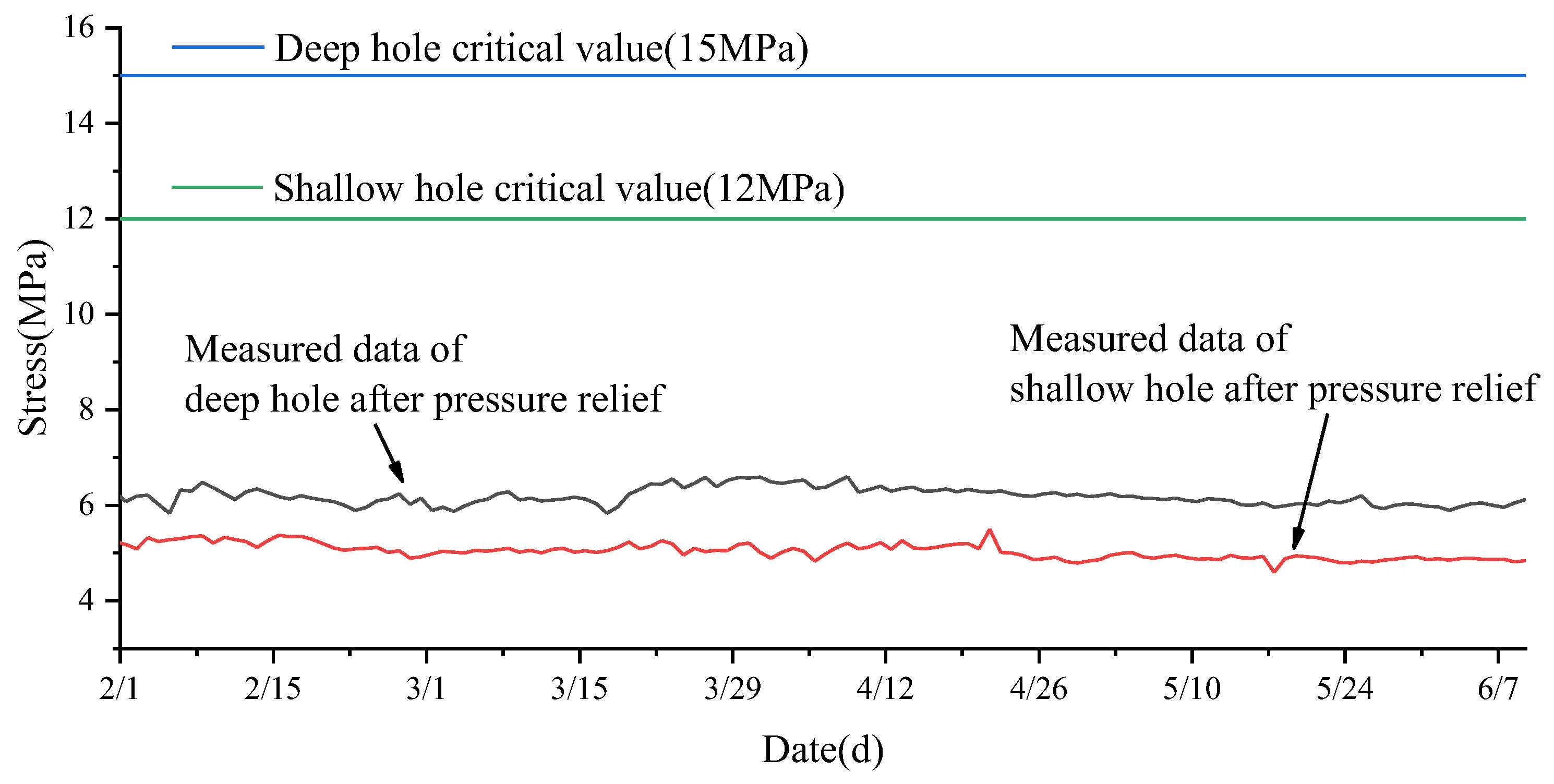
| Rock Types | Bulk Modulus (GPa) | Shear Modulus (GPa) | Tensile Strength (MPa) | Cohesion (MPa) | Friction Angle (°) |
|---|---|---|---|---|---|
| Coarse-grained sandstone | 13.24 | 13.24 | 13.24 | 13.24 | 13.24 |
| Medium-grained sandstone | 12.26 | 12.26 | 12.26 | 12.26 | 12.26 |
| Fine-grained sandstone | 7.23 | 7.23 | 7.23 | 7.23 | 7.23 |
| Coarse-grained sandstone | 8.12 | 8.12 | 8.12 | 8.12 | 8.12 |
| Sandy mudstone | 3.12 | 3.12 | 3.12 | 3.12 | 3.12 |
| Coarse grained sandstone with gravel | 10.23 | 10.23 | 10.23 | 10.23 | 10.23 |
| Silty mudstone | 3.12 | 3.12 | 3.12 | 3.12 | 3.12 |
| No.4 coal seam | 1.83 | 1.83 | 1.83 | 1.83 | 1.83 |
| Mudstone | 3.02 | 3.02 | 3.02 | 3.02 | 3.02 |
| Time | Advance Distance (m) | Maximum Energy (J) | The Central Location |
|---|---|---|---|
| 2017.08.15–08.31 | 70 | 3.21 × 103 | 33.6 m above coal seam |
| 2017.09.01–09.30 | 121 | 6.43 × 104 | 65.3 m above coal seam |
| 2017.10.01–10.31 | 66 | 3.42 × 104 | 40.2 m above coal seam |
| 2018.03.01–03.31 | 96 | 4.02 × 104 | 76.2 m above coal seam |
| 2018.04.01–04.21 | 116 | 3.40 × 105 | 85.5 m above coal seam |
| Hole Number | 1# | 2# | 3# | 4# |
|---|---|---|---|---|
| Hole depth/m | 44 | 35 | 34 | 70 |
| Elevation angle/° | 47 | 65 | 73 | 90 |
| Azimuth angle/° | 184 | 184 | 94 | |
| Explosive charge/kg | 45 | 35 | 35 | 40 |
| Explosive charge length/m | 14 | 11 | 11 | 12 |
Disclaimer/Publisher’s Note: The statements, opinions and data contained in all publications are solely those of the individual author(s) and contributor(s) and not of MDPI and/or the editor(s). MDPI and/or the editor(s) disclaim responsibility for any injury to people or property resulting from any ideas, methods, instructions or products referred to in the content. |
© 2024 by the authors. Licensee MDPI, Basel, Switzerland. This article is an open access article distributed under the terms and conditions of the Creative Commons Attribution (CC BY) license (https://creativecommons.org/licenses/by/4.0/).
Share and Cite
Jiang, B.; Xu, Y.; Li, W.; Gu, S.; Ding, M. Mechanism and Prevention of Rock Burst in a Wide Coal Pillar under the Superposition of Dynamic and Static Loads. Processes 2024, 12, 1634. https://doi.org/10.3390/pr12081634
Jiang B, Xu Y, Li W, Gu S, Ding M. Mechanism and Prevention of Rock Burst in a Wide Coal Pillar under the Superposition of Dynamic and Static Loads. Processes. 2024; 12(8):1634. https://doi.org/10.3390/pr12081634
Chicago/Turabian StyleJiang, Bangyou, Yanan Xu, Wenshuai Li, Shitan Gu, and Mingjun Ding. 2024. "Mechanism and Prevention of Rock Burst in a Wide Coal Pillar under the Superposition of Dynamic and Static Loads" Processes 12, no. 8: 1634. https://doi.org/10.3390/pr12081634






